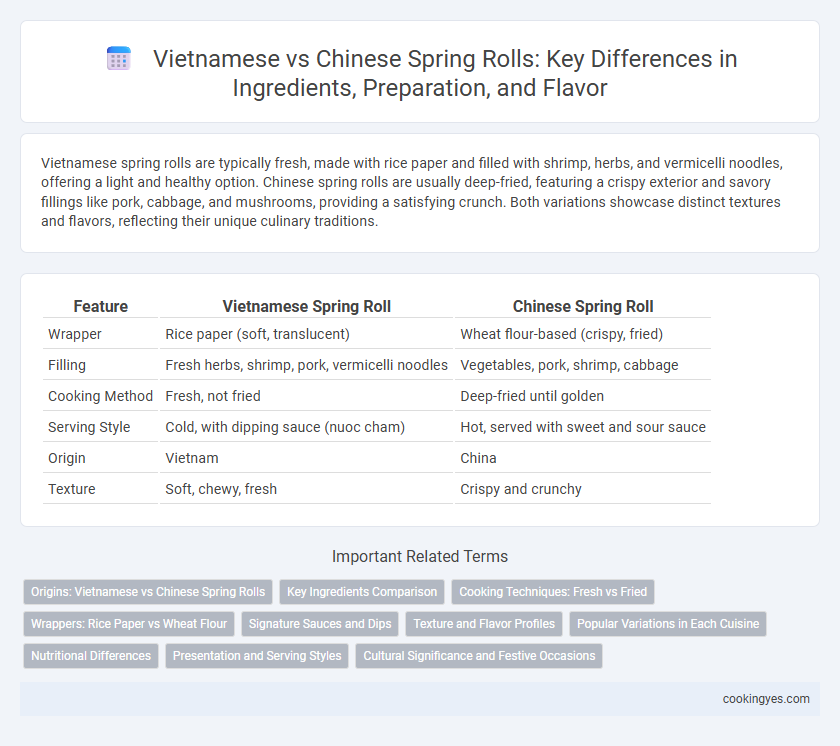Vietnamese spring rolls are typically fresh, made with rice paper and filled with shrimp, herbs, and vermicelli noodles, offering a light and healthy option. Chinese spring rolls are usually deep-fried, featuring a crispy exterior and savory fillings like pork, cabbage, and mushrooms, providing a satisfying crunch. Both variations showcase distinct textures and flavors, reflecting their unique culinary traditions.
Table of Comparison
| Feature | Vietnamese Spring Roll | Chinese Spring Roll |
|---|---|---|
| Wrapper | Rice paper (soft, translucent) | Wheat flour-based (crispy, fried) |
| Filling | Fresh herbs, shrimp, pork, vermicelli noodles | Vegetables, pork, shrimp, cabbage |
| Cooking Method | Fresh, not fried | Deep-fried until golden |
| Serving Style | Cold, with dipping sauce (nuoc cham) | Hot, served with sweet and sour sauce |
| Origin | Vietnam | China |
| Texture | Soft, chewy, fresh | Crispy and crunchy |
Origins: Vietnamese vs Chinese Spring Rolls
Vietnamese spring rolls, known as goi cuon, originated from Central and Southern Vietnam, featuring fresh rice paper wrapped around herbs, shrimp, pork, and vermicelli, emphasizing fresh ingredients and lighter flavors. Chinese spring rolls date back to the Eastern Jin Dynasty, traditionally consisting of wheat-based wrappers filled with cooked vegetables or meat, then deep-fried for a crispy texture. Both varieties showcase distinct culinary heritages, with Vietnamese rolls focusing on fresh, uncooked fillings while Chinese rolls are usually fried and cooked.
Key Ingredients Comparison
Vietnamese spring rolls typically feature fresh rice paper wrappers filled with shrimp, herbs like mint and cilantro, rice vermicelli, and sometimes pork, emphasizing lightness and herbal freshness. Chinese spring rolls use wheat flour wrappers that are deep-fried to a crispy texture, with fillings often consisting of finely shredded vegetables such as cabbage, carrots, and sometimes minced pork or shrimp, offering a savory and crunchy bite. The difference in wrapper type and ingredient selection highlights the Vietnamese preference for freshness and the Chinese focus on texture and savory richness.
Cooking Techniques: Fresh vs Fried
Vietnamese spring rolls, known as Goi cuon, are typically fresh and served cold, featuring translucent rice paper wrappers filled with herbs, shrimp, and vermicelli, emphasizing a light and healthy preparation. In contrast, Chinese spring rolls are commonly deep-fried to achieve a crispy, golden exterior, showcasing versatile fillings like pork, vegetables, or seafood, highlighting rich flavors and a crunchy texture. These distinct cooking techniques reflect cultural preferences, with Vietnamese rolls prioritizing freshness and subtlety while Chinese versions focus on warmth and crispiness.
Wrappers: Rice Paper vs Wheat Flour
Vietnamese spring rolls typically use translucent rice paper wrappers made from rice flour, water, and salt, offering a light, chewy texture perfect for fresh, uncooked fillings. Chinese spring rolls commonly feature wheat flour-based wrappers that are thicker and more doughy, ideal for deep frying and achieving a crispy exterior. The rice paper's delicate nature contrasts with the wheat wrapper's robustness, influencing both preparation methods and flavor profiles.
Signature Sauces and Dips
Vietnamese spring rolls commonly feature a signature hoisin-peanut dipping sauce flavored with garlic, crushed peanuts, and chili, enhancing their fresh, herb-filled rolls. Chinese spring rolls often accompany a sweet and sour sauce or a soy-based dipping sauce infused with ginger and garlic, complementing their crispy, fried texture. These distinct sauces highlight differences in regional flavor profiles, emphasizing Vietnamese freshness versus Chinese savory richness.
Texture and Flavor Profiles
Vietnamese spring rolls feature a fresh, crisp texture with delicate rice paper wrappers and a vibrant combination of herbs, shrimp, and vermicelli, delivering a light, herbal, and slightly tangy flavor profile. Chinese spring rolls typically have a thicker, fried wheat flour wrapper, offering a crunchy exterior and a savory, rich filling often composed of pork, cabbage, and mushrooms, resulting in a robust, umami taste. The contrast in textures--chewy and fresh versus crunchy and hearty--highlights the distinct culinary traditions behind each variation.
Popular Variations in Each Cuisine
Vietnamese spring rolls often feature fresh herbs, rice paper wrappers, and a combination of shrimp, pork, and vermicelli noodles, emphasizing light and refreshing flavors. Chinese spring rolls typically use a thin wheat flour wrapper filled with a variety of cooked ingredients like cabbage, mushrooms, and minced pork, then deep-fried to a crispy texture. Each cuisine showcases distinct preparation methods and ingredient choices that highlight their cultural taste preferences and culinary traditions.
Nutritional Differences
Vietnamese spring rolls typically contain fresh vegetables, herbs, and lean proteins like shrimp, making them lower in calories and rich in vitamins and fiber compared to Chinese spring rolls, which are often deep-fried and filled with meat, resulting in higher fat and calorie content. The fresh ingredients in Vietnamese spring rolls provide antioxidants and essential nutrients, supporting a balanced diet and digestive health. In contrast, the frying process in Chinese spring rolls increases saturated fat and sodium levels, potentially impacting heart health when consumed frequently.
Presentation and Serving Styles
Vietnamese spring rolls typically feature translucent rice paper wrappers showcasing fresh herbs, vermicelli noodles, and shrimp or pork, served chilled with a side of tangy hoisin-peanut dipping sauce that highlights their crisp, fresh ingredients. Chinese spring rolls are usually wrapped in a thicker, wheat-based wrapper, fried to a golden brown, delivering a crunchy texture, and often served hot with sweet and sour or soy-based sauces. The Vietnamese style emphasizes lightness and freshness through presentation, while the Chinese style focuses on a crispy exterior and warm serving temperature for a hearty experience.
Cultural Significance and Festive Occasions
Vietnamese spring rolls, known as "goi cuon," hold deep cultural significance during Tet, the Vietnamese Lunar New Year, symbolizing prosperity and new beginnings. Chinese spring rolls are traditionally enjoyed during the Spring Festival, representing wealth and good fortune due to their golden, crispy exterior. Both variations play essential roles in their respective festive celebrations, embodying family unity and cultural heritage.
Vietnamese vs Chinese for spring rolls Infographic

 cookingyes.com
cookingyes.com